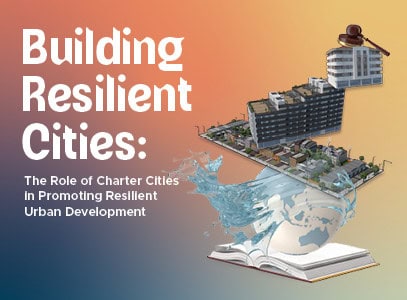The Charter Cities Institute (CCI) is pleased to announce the launch of our Reference Guides for charter cities. The Reference Guides are a series of documents designed to be used by charter city developers to improve their decision-making and assist them in the creation of legal institutions to govern the charter city. Today we are releasing a Model Charter, Model Legislation, a Risk Mitigation Guide, and an Introduction to Charter Cities.
Part of the reason Silicon Valley is successful at producing startups is because critical knowledge and relationships are embedded in its ecosystem. There is common knowledge about what a startup is, there are clearly defined mechanisms for fundraising, and there are mentorship networks for successful founders. This ecosystem allows Silicon Valley to be one of the most innovative places in the world, despite high taxes and high housing prices.
The charter cities movement, still in its relative infancy, lacks a comparatively complex ecosystem. There are differing understandings of what a charter city even is, let alone the specific details of creating a legal system from scratch. There are no mentors who have built successful new cities and now offer themselves to the next generation of entrepreneurs to provide guidance and advice. Even the path and sequencing of actions necessary to build charter cities is unclear. This uncertainty inhibits success.
Accelerating charter city development requires a coordinated approach. This means early successes need to be understood and celebrated. Constant discussion in the ecosystem is crucial to share best practices, and by doing so replicate initial successes. In fact, one of the goals of CCI is to create exactly this type of replicable model for charter cities– what CCI likes to call “charter cities in a box.” We are breaking down every element of charter cities– from governance to site selection to urban planning to financing– to develop a general model that can be adapted and applied in various conditions. This model will empower entrepreneurs and governments across the world to start taking the first steps towards building their own successful charter cities.
The Reference Guides are the first step towards this general model. The Introduction to Charter Cities defines what charter cities are, where they draw inspiration from, and key elements to consider in their construction. The Model Charter defines the authority of the city government. The Model Legislation can be adopted by countries interested in establishing a charter city. Lastly, the Risk Mitigation Guide delineates how a charter city can minimize various risks, including security risks and the risk of expropriation.
While each of these documents is written to be useful in and of themselves, they combine to form a more valuable whole. The Model Legislation creates a process by which developers can apply for charter city status. After a developer is approved via the process described in the Model Legislation, they need to create a charter to govern the city, for which the Model Charter offers a template. The Risk Mitigation Guide describes the various risks facing a charter city and how to avoid them.
The Introduction to Charter Cities ties the various threads together. It’s difficult to develop a charter city without have a clear understanding of what charter cities are. The Introduction to Charter Cities addresses (i) the challenges being faced in emerging markets today and how charter cities can help solve them, (ii) the different histories that the charter cities movement draws from, and (iii) defines key elements that need to be considered to maximize the likelihood of success for a given charter city development.
This is only the beginning of CCI’s planned Reference Guides. Our Head of Research Kurtis Lockhart is working with Jeffrey Mason and Mo Malabu in the creation of a Governance Handbook. The Governance Handbook will be a step-by-step guide to creating a legal system from scratch, covering everything from the city agencies to establish to the legal ordinances to be implemented. Additionally, our two Atlas Fellows, Heba Elhanafy and Emmanuel Olawoye, along with intern Jidy Chitta, are working on a Master Urban Plan for a model charter city. The Master Urban Plan is for a 20,000-acre city for 1 million residents with starting per capita income of $1,500 built over a period of 30 years. A key element of the Master Urban Plan is a financial model which we hope will help push down the price point of charter city developments.
The Governance Handbook and the Master Urban Plan, along with the Reference Guides released today, serve to create a clear framework for building charter cities. In case any funders are reading, another Reference Guide CCI would like to develop is a Site Map, which would pinpoint optimal site locations for would-be charter cities. More specifically, the Site Map would seek to identify locations of at least 20,000+ available acres within two hours of an airport, in regions undergoing rapid urbanization. The Governance Handbook will be released later this year and the Master Urban Plan will be released in 2021.
CCI is developing a replicable model for charter cities. The goal of these Reference Guides is to help inspire and seed a dozen or more charter cities. Of course, documents and research alone are not enough. The Charter Cities Institute is working on the ground with new cities including Nkwashi, Zambia; Enyimba Economic City, Nigeria; and Talent City, Nigeria. We believe combining practical knowledge gleaned from real-world projects, together with our research, will allow us to develop a generalizable model for charter cities that can help turn the most rapid urbanization in human history from a challenge into an opportunity.
We would like to thank Iyinoluwa Aboyeji, Alain Bertaud, Jason Crawford, Paul Healy, Bonnie Kavoussi, Mark Levin, Lotta Moberg, Mwiya Musokotwane, Jorge Colindres, Carl Peterson, José Luis Ricón, and Alex Tabarrok for their comments improving the Reference Guides. Any errors remain our own.







